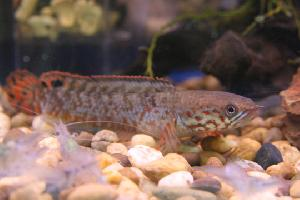
Popis zvířete
The Northern snakehead (Channa argus) is a remarkable species of fish that has garnered attention due to its unique characteristics and its status as an invasive species in some parts of the world. Native to China, Russia, and Korea, this freshwater fish is known for its resilience and adaptability, traits that have allowed it to thrive in diverse environments outside its native range.Physically, the Northern snakehead is an impressive creature. It can grow to lengths of up to 1 meter (about 3 feet), though sizes of around 65-70 centimeters (approximately 2 feet) are more common. Its elongated body is muscular and serpentine, with scales that can range in color from dark brown to a greenish hue, providing excellent camouflage among aquatic plants and muddy waters. The fish's name comes from its large, slightly flattened head and wide mouth, which bears a resemblance to that of a snake. Inside its mouth, sharp, needle-like teeth are arrayed in multiple rows, designed to grasp and hold onto slippery prey.
One of the most fascinating aspects of the Northern snakehead is its respiratory system. Unlike most fish, which rely solely on gills to breathe underwater, the Northern snakehead possesses a specialized labyrinth organ that allows it to breathe atmospheric air. This adaptation enables it to survive in waters with low oxygen levels and even to temporarily move overland for short distances during wet conditions, searching for new habitats or escaping from desiccated water bodies.
The diet of the Northern snakehead is as versatile as its habitat preferences. It is an apex predator in its ecosystem, feeding on a wide variety of prey, including fish, crustaceans, small mammals, and even birds. Its predatory nature, combined with a high reproductive rate — a single female can lay thousands of eggs in a year — poses a significant threat to local biodiversity in regions where it is introduced.
The introduction of the Northern snakehead into non-native ecosystems, often through the pet trade or as a byproduct of unauthorized release, has led to numerous ecological challenges. In areas like the United States, where the fish has no natural predators, it has the potential to disrupt local aquatic ecosystems by outcompeting native species for resources and altering food webs.
Conservationists and environmental management agencies have taken various measures to control the spread of the Northern snakehead, including public awareness campaigns, fishing derbies, and even culinary promotions to encourage the consumption of the fish. Despite these efforts, the Northern snakehead remains a species of concern due to its resilience and ability to rapidly adapt to new environments.
In conclusion, the Northern snakehead (Channa argus) is a species of fish that fascinates and worries biologists and environmentalists alike. Its unique physiological traits, such as the ability to breathe air and move over land, combined with its aggressive nature and adaptability, make it a resilient survivor but also a formidable invasive species that poses a threat to ecosystems where it is not native.
Podobná zvířata
Nové fotografie zvířat
Top 10 zvířat
- Dolphin gull (Leucophaeus scoresbii)
- Diana monkey (Cercopithecus diana)
- Moustached guenon (Cercopithecus cephus)
- Galápagos tortoise (Geochelone nigra complex)
- Stone loach (Barbatula barbatula)
- Japanese macaque (Macaca fuscata)
- Russian tortoise (Testudo horsfieldii)
- Greek tortoise (Testudo graeca)
- Common flying dragon (Draco volans)
- Vendace (Coregonus albula)

